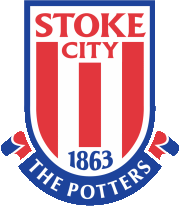
STOKE CITY F.C.
Founded: 1863
Also Known As:
STOKE RAMBLERS (1863-78)
STOKE (1878-1928)
STOKE CITY (1928-)
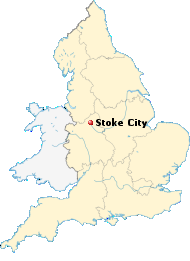
CLICK ON THE MAP TO
VIEW ENLARGED MAP
|
STOKE CITY F.C. (Football Club)
Included Info: Brief History, Club/Stadium Info, Team Jersey & Much More...
BRIEF HISTORY of STOKE CITY FOOTBALL CLUB
(reproduced from 'Wikipedia' pages)
Stoke City F.C. was formed in 1863 under the name Stoke Ramblers, when pupils of Charterhouse School
formed a football club while apprentices at the North Staffordshire Railway works in Stoke-upon-Trent.
In 1878, the club merged with Stoke Victoria Cricket Club, and became Stoke Football Club. They moved
from their previous ground, Sweetings Field, to the Athletic Club ground, which soon became known as
the Victoria Ground. It was around this time that the club adopted their traditional red-and-white
striped kit. In August 1885, the club turned professional. Stoke were one of the twelve founding members
of the Football League when it was introduced in 1888. The club struggled in their first two seasons,
1888–89 and 1889–90, finishing bottom on both occasions. In 1890 Stoke failed to be re-elected and joined
the Football Alliance, which they won and thus were re-elected to the Football League. Stoke spent the next
15 seasons in the First Division and reached the FA Cup Semi-Final in the 1898–99 season before being
relegated in 1907. Stoke went bankrupt and entered non-league football until 1914, when the First World War
meant the Football League was suspended for four years. When football recommenced in August 1919, Stoke
re-joined the league. The club became owners of the Victoria Ground in 1919. This was followed by the
construction of the Butler Street stand, which increased the overall capacity of the ground to 50,000.
In 1925, Stoke-on-Trent was granted "city status" and this led the club to change its name to Stoke City F.C.
in 1928.
Following the resumption of the FA Cup after World War II, tragedy struck on 9 March 1946, as 33 fans died
and 520 were injured during a 6th round tie away against Bolton Wanderers. This came known as the Burnden Park
disaster. In 1946–47, Stoke mounted a serious title challenge. The club needed a win in their final game of the
season to win the First Division title. However, a 2–1 defeat to Sheffield United meant the title went to Liverpool
instead. Stoke were relegated from the First Division in 1952–53; during the season Bob McGrory resigned as the
club's manager after 17 years in the role. Former Wolverhampton Wanderers defender Frank Taylor took over at the
club looking to gain promotion back to the First Division. However after seven seasons in the Second Division
without promotion, Taylor was sacked. The club won its first major trophy on 4 March 1972 in the League Cup Final.
Stoke beat favourites Chelsea 2–1 in the final at Wembley Stadium in front of a crowd of 97,852 spectators.
Preceding this victory, Stoke had progressed through 11 games in order to reach the final. This included four
games with West Ham United in the semi-final; the two-legged tie was replayed twice. Stoke fared well in the
FA Cup; the club progressed to the semi-final stage in both the 1970–71 and 1971–72 seasons. However, on both
occasions Stoke lost to Arsenal in a replay. Stoke City also became the first First Division side to play a
match on a Sunday, when they faced Chelsea on 27 January 1974. In January 1976 the roof of the Butler Street
Stand was blown off in a storm. The repair bill of nearly £250,000 put the club in financial trouble; key
players such as Alan Hudson, Mike Pejic and Jimmy Greenhoff were sold to cover the repairs. With the team
depleted, Stoke were relegated in the 1976–77 season.
The 1984–85 season proved to be disastrous. Stoke finished the season with only 17 points, with just 3 wins
all season. In 1989–90, and Stoke were relegated to the third tier of English football after finishing bottom of
the Second Division. Ball kept his job for the start of the following season, 1990–91, but departed during February
1991, in an indifferent season that saw Stoke finish 15th in the Third Division. Stoke's lowest league position
in the Football League. The following season, 1992–93, promotion was achieved from the third tier. Macari left
in October 1993 to be replaced by Joe Jordan; Stein also departed, in a club record £1.5m move to Chelsea.
1997–98 saw Stoke move to its new ground, the Britannia Stadium, after 119 years at the Victoria Ground.
The Auto Windscreens Shield was won in the 1999–2000 season, in April 2000, with a win over Bristol City in
front of a crowd of 85,057 at Wembley. Stoke won automatic promotion to the Premier League on the final day
of the 2007–08 season, finishing in 2nd place in the Championship. Stoke finished the following 2009–10 season
in a respectable 11th place, with 47 points. Stoke also made it to the quarter finals of the FA Cup for the first
time since 1972, beating York City, Arsenal and Manchester City before losing out to eventual winners Chelsea.
The 2010–11 season gave Stoke two new records; their largest away win in the Premier League, and their largest
top division away win since 1982. It was also the first time since the 1983–84 season that Stoke had won three
top-flight matches in a row. Stoke reached the FA Cup Final for the first time, beating Cardiff City, Wolverhampton
Wanderers, Brighton & Hove Albion, West Ham United and a famous win of 5–0 against Bolton Wanderers (the biggest
post war FA Cup Semi-Final victory). However, they lost the final 1–0 to Manchester City. By reaching the final,
Stoke qualified for the 2011–12 UEFA Europa League. In the UEFA Europa League Stoke advanced past Hajduk Split,
FC Thun, and a tough group containing Besiktas, Dynamo Kyiv and Maccabi Tel Aviv which Stoke managed to progress
through finishing in second position. City's reward was a tie against Spanish giants Valencia and despite putting
up a spirited 2nd leg performance Stoke went out 2–0 on aggregate. In the Premier League Stoke made the high-profile
signing of Peter Crouch as they finished in a mid-table position for a fourth time. Stoke finished in ninth place
in 2013–14, their highest position in the Premier League and best finish since 1974–75.
|
CLUB FACTS & INFORMATION
| Official Name
| --
| Stoke City F.C. |
| Club Nickname
| --
| The Potters |
| Year Founded
| --
| 1863 (154 years ago) |
| English County
| --
| Staffordshire |
| Current Ground
| --
| Britannia Stadium |
| Ground Location
| --
| Stoke-on-Trent, England |
| Club's Owner
| --
| Denise Coates (Bet365) |
| Club Chairman
| --
| Peter Coates |
| Current Manager
| --
| Mark Hughes |
| Current League
| --
| Premier League |
| Last Season
| --
| Premier League, 13th place |
HOME COLORS

Red & White |
AWAY COLORS

Black w/Green Trim |
|
| |
INTERESTING STADIUM FACTS & INFORMATION

BRITANNIA STADIUM
Stanley Matthews Way, Stoke-on-Trent,
Staffordshire, ST4-4EG, England
OPENED: ......... August 30, 1997
SURFACE: ........ Grass
COST: .............. $14.7 Million
CAPACITY: ...... 27,902
RECORD: ......... 26,322 (2011 vs Hajduk Split)
OWNER: ........... Stoke City F.C.
OPERATOR: ..... Stoke City F.C.
FIELD SIZE: ..... 109 x 70 yards (100 x 64 meters)
|
|
|
HOME JERSEY
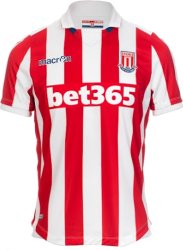 |
AWAY JERSEY
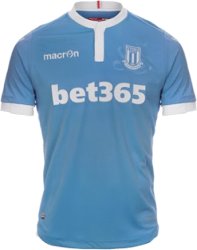 |
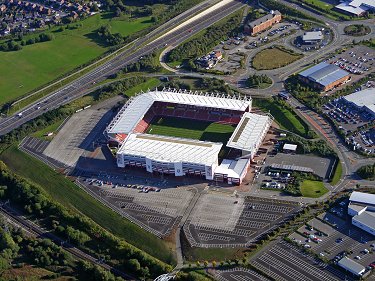
Click On Aerial Photo To View/Download Enlarged Image
|
Britannia Stadium (Stoke City) Seating Diagram
Click On Diagram Below To Enlarge View
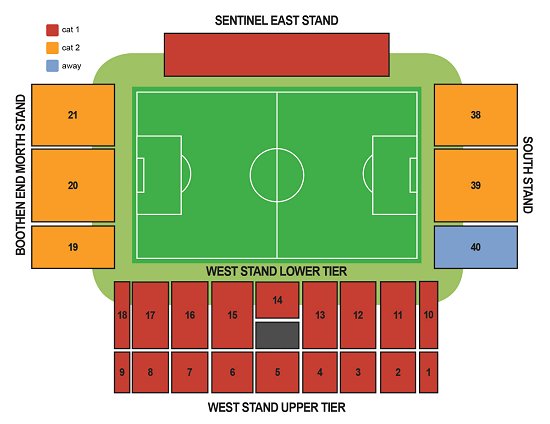
|



STOKE CITY STADIUM WALLPAPERS (Free Download)
Wallpaper Size below is 800x600: To Download Bigger Sizes, Click On Any Button Shown Above
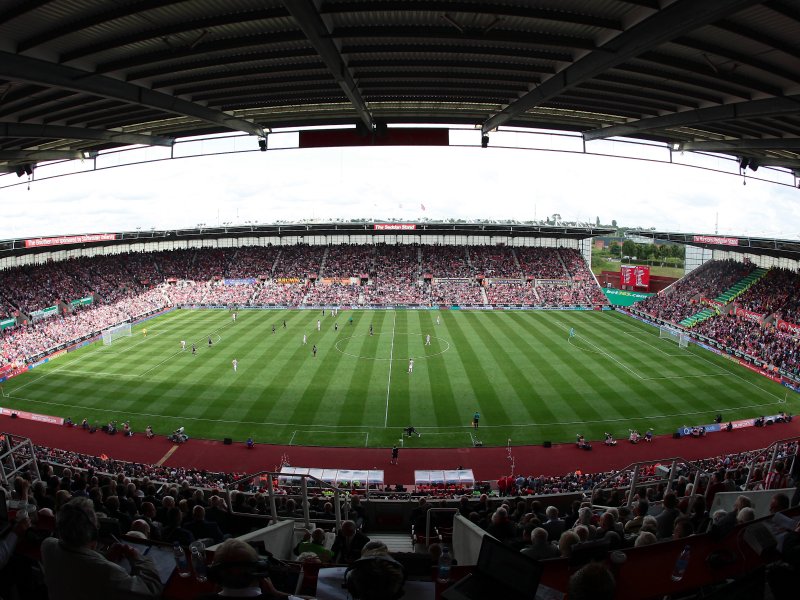
|
|

